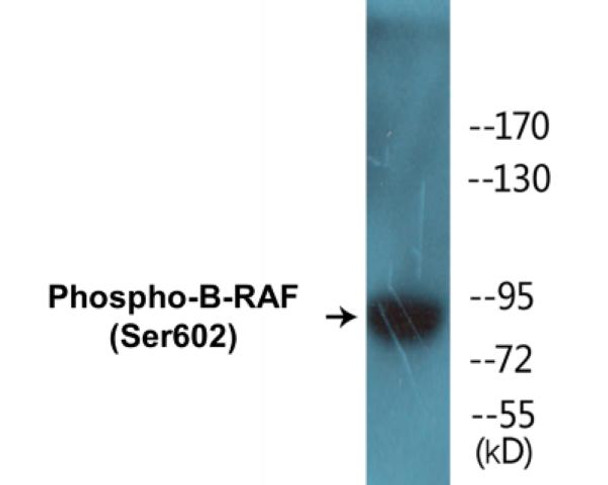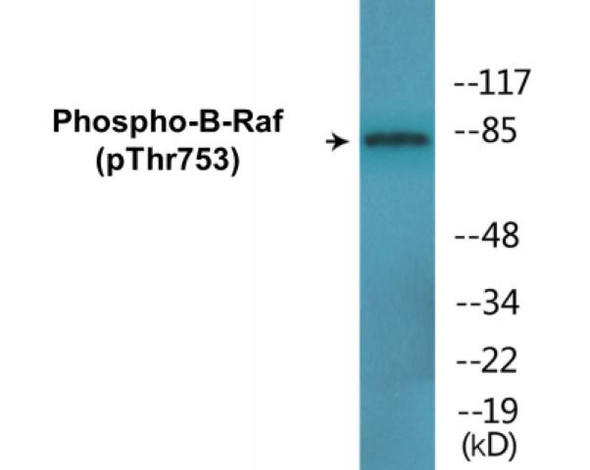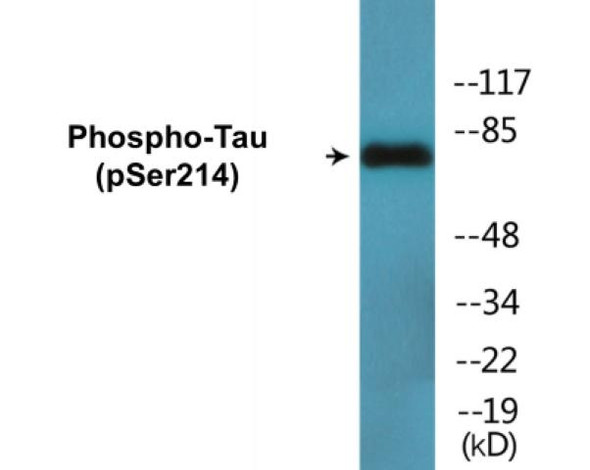Description
B-RAF (Phospho-Ser602) Cell-Based ELISA Kit
The B-RAF (Phospho-Ser602) Cell-Based ELISA Kit is a convenient, lysate- free, high throughput and sensitive assay kit that can monitor B-RAF phosphorylation and expression profile in cells. The kit can be used for measuring the relative amounts of phosphorylated B-RAF in cultured cells as well as screening for the effects that various treatments, inhibitors (ie. siRNA or chemicals), or activators have on B-RAF phosphorylation.
How does our B-RAF (Phospho-Ser602) Fluorometric Cell-Based ELISA Kit work?
Qualitative determination of B-RAF (Phospho-Ser602) concentration is achieved by an indirect ELISA format. In essence, B-RAF (Phospho-Ser602) is captured by B-RAF (Phospho-Ser602)-specific primary (1°) antibodies while Dye 1-conjugated and Dye 2-conjugated secondary (2°) antibodies bind the Fc region of the 1° antibody. Through this binding, the dye conjugated to the 2° antibody can emit light at a certain wavelength given proper excitation, hence allowing for a fluorometric detection method. Due to the qualitative nature of the Cell-Based ELISA, multiple normalization methods are needed:
| 1. | A monoclonal antibody specific for human GAPDH is included to serve as an internal positive control in normalizing the target RFU values. |
| 2. | An antibody against the nonphosphorylated counterpart of B-RAF (Phospho-Ser602) is also provided for normalization purposes. The RFU values obtained for non-phosphorylated B-RAF can be used to normalize the RFU value for phosphorylated B-RAF. |
B-RAF (Phospho-Ser602) Fluorometric Cell-Based ELISA Kit -Information
| Product Name: | B-RAF (Phospho-Ser602) Fluorometric Cell-Based ELISA Kit |
| Product Code/SKU: | FBCAB00045 |
| Description: | The B-RAF (Phospho-Ser602) Fluorometric Cell-Based Phospho ELISA Kit is a convenient, lysate-free, high throughput and sensitive assay kit that can monitor B-RAF (Phospho-Ser602) protein phosphorylation and expression profile in cells. The kit can be used for measuring the relative amounts of phosphorylated B-RAF (Phospho-Ser602) in cultured cells as well as screening for the effects that various treatments, inhibitors (ie. siRNA or chemicals, or activators have on BRAF1 phosphorylation. |
| Dynamic Range: | > 5000 Cells |
| Detection Method: | Fluorometric |
| Storage/Stability: | 4°C/6 Months |
| Reactivity: | Human, Mouse, Rat |
| Assay Type: | Cell-Based ELISA |
| Database Links: | Gene ID: 673, UniProt ID: P15056, OMIM #: 114500/115150/164757/211980/605027, Unigene #: Hs.550061 |
| Format: | Two 96-Well Plates |
| NCBI Gene Symbol: | BRAF1 |
| Sub Type: | Phospho |
| Target Name: | Phospho-B-RAF (Ser602) |
Kit Principle
Figure: Schematic representation of Assay Genie Cell-Based Fluorometric ELISA principle
Kit components | Quantity |
| 96-Well Black Cell CultureClear-Bottom Microplate | 2 plates |
| 10X TBS | 24 ml |
| Quenching Buffer | 24 ml |
| Blocking Buffer | 50 ml |
| 15X Wash Buffer | 50 ml |
| Primary Antibody Diluent | 12 ml |
| 100x Anti-Phospho Target Antibody | 60 µl |
| 100x Anti-Target Antibody | 60 µl |
| Anti-GAPDH Antibody | 110 µl |
| Dye-1 Conjugated Anti-Rabbit IgG Antibody | 6 ml |
| Dye-2 Conjugated Anti-Mouse IgG Antibody | 6 ml |
| Adhesive Plate Seals | 2 seals |
Additional equipment and materials required
The following materials and/or equipment are NOT provided in this kit but are necessary to successfully conduct the experiment:
- Fluorescent plate reader with two channels at Ex/Em: 651/667 and 495/521
- Micropipettes capable of measuring volumes from 1 µl to 1 ml
- Deionized or sterile water (ddH2O)
- 37% formaldehyde (Sigma Cat# F-8775) or formaldehyde from other sources
- Squirt bottle, manifold dispenser, multichannel pipette reservoir or automated microplate washer
- Graph paper or computer software capable of generating or displaying logarithmic functions
- Absorbent papers or vacuum aspirator
- Test tubes or microfuge tubes capable of storing ≥1 ml
- Poly-L-Lysine (Sigma Cat# P4832 for suspension cells)
- Orbital shaker (optional)
Kit Protocol
This is a summarized version of the kit protocol. Please view the technical manual of this kit for information on sample preparation, reagent preparation and plate lay out.
| 1. | Seed 200 µl of desired cell concentration in culture medium into each well of the 96-well plates. For suspension cells and loosely attached cells, coat the plates with 100 µl of 10 µg/ml Poly-L-Lysine (not included) to each well of a 96-well plate for 30 minutes at 37°C prior to adding cells. |
| 2. | Incubate the cells for overnight at 37°C, 5% CO2. |
| 3. | Treat the cells as desired. |
| 4. | Remove the cell culture medium and rinse with 200 µl of 1x TBS, twice. |
| 5. | Fix the cells by incubating with 100 µl of Fixing Solution for 20 minutes at room temperature. The 4% formaldehyde is used for adherent cells and 8% formaldehyde is used for suspension cells and loosely attached cells. |
| 6. | Remove the Fixing Solution and wash the plate 3 times with 200 µl 1x Wash Buffer for 3 minutes. The plate can be stored at 4°C for a week. |
| 7. | Add 100 µl of Quenching Buffer and incubate for 20 minutes at room temperature. |
| 8. | Wash the plate 3 times with 1x Wash Buffer for 3 minutes each time. |
| 9. | Dispense 200 µl of Blocking Buffer and incubate for 1 hour at room temperature. |
| 10. | Wash 3 times with 200 µl of 1x Wash Buffer for 3 minutes each time. |
| 11. | Add 50 µl of Primary Antibody Mixture P to corresponding wells for B-RAF (Phospho-Ser602) detection. Add 50 µl of Primary Antibody Mixture NP to the corresponding wells for total B-RAF detection. Cover the plate with parafilm and incubate for 16 hours (overnight) at 4°C. If the target expression is known to be high, incubate for 2 hours at room temperature. |
| 12. | Wash 3 times with 200 µl of 1x Wash Buffer for 3 minutes each time. |
| 13. | Add 50 ul of Secondary Antibody Mixture to corresponding wells and incubate for 1.5 hours at room temperature in the dark. |
| 14. | Wash 3 times with 200 µl of 1x Wash Buffer for 3 minutes each time. |
| 15. | Read the plate(s) at Ex/Em: 651/667 (Dye 1) and 495/521 (Dye 2). Shield plates from direct light exposure. |
| 16. | Wash 3 times with 200 µl of 1x Wash Buffer for 5 minutes each time. |
B-RAF (Phospho-Ser602) - Protein Information
| UniProt Protein Function: | BRAF: a tyrosine kinase-like kinase of the RAF family. Involved in the transduction of mitogenic signals from the cell membrane to the nucleus. May play a role in the postsynaptic responses of hippocampal neuron. Frequently mutated in thyroid cancers, skin melanomas and at lower frequency in a wide range of human cancers. An activating mutation, mimicking phosphorylation of the activation loop, is seen in 60% of malignant melanoma samples. Raf mutations are generally exclusive to Ras activating mutations. Activating mutations are also seen in ~10% of colorectal cancers, in lung cancers and gliomas, and at a lower rate in several other tumors. Inactivating mutations are also seen and may result in activation of c-Raf and Erk. Mutations in B-Raf, MEK1 and MEK2 also associated with cardiofaciocutaneous syndrome, displaying morphological, cardiac and mental defects. Approved Inhibitor: Nexavar/Sorafenib. |
| UniProt Protein Details: | Protein type:Kinase, protein; Protein kinase, Ser/Thr (non-receptor); Protein kinase, TKL; Oncoprotein; EC 2.7.11.1; TKL group; RAF family Chromosomal Location of Human Ortholog: 7q34 Cellular Component: neuron projection; mitochondrion; plasma membrane; cytosol; nucleus Molecular Function:small GTPase binding; protein serine/threonine kinase activity; identical protein binding; protein binding; MAP kinase kinase kinase activity; mitogen-activated protein kinase kinase binding; protein heterodimerization activity; calcium ion binding; ATP binding; protein kinase activity Biological Process: positive T cell selection; response to peptide hormone stimulus; fibroblast growth factor receptor signaling pathway; response to cAMP; CD4-positive, alpha beta T cell differentiation; activation of MAPKK activity; nerve growth factor receptor signaling pathway; somatic stem cell maintenance; protein heterooligomerization; MAPKKK cascade; protein amino acid phosphorylation; positive regulation of peptidyl-serine phosphorylation; regulation of cell proliferation; synaptic transmission; organ morphogenesis; myeloid progenitor cell differentiation; small GTPase mediated signal transduction; positive regulation of stress fiber formation; visual learning; negative regulation of neuron apoptosis; negative regulation of apoptosis Disease: Noonan Syndrome 1; Noonan Syndrome 7; Lung Cancer; Cardiofaciocutaneous Syndrome 1; Leopard Syndrome 3 |
| NCBI Summary: | This gene encodes a protein belonging to the raf/mil family of serine/threonine protein kinases. This protein plays a role in regulating the MAP kinase/ERKs signaling pathway, which affects cell division, differentiation, and secretion. Mutations in this gene are associated with cardiofaciocutaneous syndrome, a disease characterized by heart defects, mental retardation and a distinctive facial appearance. Mutations in this gene have also been associated with various cancers, including non-Hodgkin lymphoma, colorectal cancer, malignant melanoma, thyroid carcinoma, non-small cell lung carcinoma, and adenocarcinoma of lung. A pseudogene, which is located on chromosome X, has been identified for this gene. [provided by RefSeq, Jul 2008] |
| UniProt Code: | P15056 |
| NCBI GenInfo Identifier: | 50403720 |
| NCBI Gene ID: | 673 |
| NCBI Accession: | P15056.4 |
| UniProt Secondary Accession: | P15056,Q13878, Q3MIN6, Q9UDP8, Q9Y6T3, A4D1T4, B6HY61 B6HY62, B6HY63, B6HY64, B6HY65, B6HY66, |
| UniProt Related Accession: | P15056 |
| Molecular Weight: | 84kDa |
| NCBI Full Name: | Serine/threonine-protein kinase B-raf |
| NCBI Synonym Full Names: | B-Raf proto-oncogene, serine/threonine kinase |
| NCBI Official Symbol: | BRAF |
| NCBI Official Synonym Symbols: | NS7; BRAF1; RAFB1; B-RAF1 |
| NCBI Protein Information: | serine/threonine-protein kinase B-raf; 94 kDa B-raf protein; proto-oncogene B-Raf; v-raf murine sarcoma viral oncogene homolog B; v-raf murine sarcoma viral oncogene homolog B1; murine sarcoma viral (v-raf) oncogene homolog B1; B-Raf proto-oncogene serine/threonine-protein kinase (p94) |
| UniProt Protein Name: | Serine/threonine-protein kinase B-raf |
| UniProt Synonym Protein Names: | Proto-oncogene B-Raf; p94; v-Raf murine sarcoma viral oncogene homolog B1 |
| Protein Family: | Serine/threonine-protein kinase |
| UniProt Gene Name: | BRAF |
| UniProt Entry Name: | BRAF_HUMAN |







